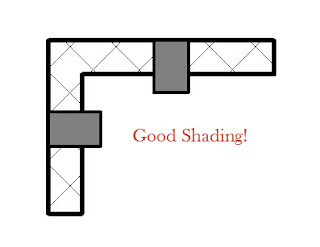Working with a client the last couple evenings I found a quirky condition with a column family that has a nested detail component to manage masking the way they like. When the column is playing nicely it looks like this.
Unfortunately they all, nearly all, look like this now.
After pressing many buttons, clicking even more and checking, double checking settings...no joy. Then I tried changing the column to use the Column Style settings: Slanted - Angle Driven and Slanted - End Point Driven. They all report Vertical now but changing the value and then changing back made no difference. So I tried placing another column fresh, it works. At least that's something. Then I tried to break it. More button pressing etc. and then I come back to the Column Style settings.
After changing from Vertical to Slanted - End Point Driven it won't shade/mask anymore. Hmmm... Well I've manage to break it, that's something I suppose.
I tried to swap all the columns out with a completely new type from a different column family. Then I deleted (purged) the original family and loaded one fresh with a new name even. Swap back...no joy :(
It sure looks like the only option is to place new columns carefully where the original obstinate ones are thumbing their noses at us. Yuk...
Fwiw, it isn't actually necessary to include a nested detail component. Usually assigning a solid cut pattern and altering the color to gray is sufficient. These images are actually showing that approach, no nested detail component. That just means the problem is more intractable, not related to the nested component at all. I suspect that the angle column settings "rotate" the "shading" out of plumb and then the columns lose the ability to do it anymore. Much like annotation graphics in lighting fixtures won't show up on sloped ceilings, just the 3D geometry.
I did find that I could swap out good for bad if I used Groups. I created a group out of one good column, with the group origin at center. Then I made individual groups of the bad columns. I just made sure the origin faced the same direction for each. This wasn't fast... Then I selected all the rogue "groups" and swapped them all for the single good group definition. All fixed...ungroup. ugh
Unfortunately they all, nearly all, look like this now.
After pressing many buttons, clicking even more and checking, double checking settings...no joy. Then I tried changing the column to use the Column Style settings: Slanted - Angle Driven and Slanted - End Point Driven. They all report Vertical now but changing the value and then changing back made no difference. So I tried placing another column fresh, it works. At least that's something. Then I tried to break it. More button pressing etc. and then I come back to the Column Style settings.
After changing from Vertical to Slanted - End Point Driven it won't shade/mask anymore. Hmmm... Well I've manage to break it, that's something I suppose.
I tried to swap all the columns out with a completely new type from a different column family. Then I deleted (purged) the original family and loaded one fresh with a new name even. Swap back...no joy :(
It sure looks like the only option is to place new columns carefully where the original obstinate ones are thumbing their noses at us. Yuk...
Fwiw, it isn't actually necessary to include a nested detail component. Usually assigning a solid cut pattern and altering the color to gray is sufficient. These images are actually showing that approach, no nested detail component. That just means the problem is more intractable, not related to the nested component at all. I suspect that the angle column settings "rotate" the "shading" out of plumb and then the columns lose the ability to do it anymore. Much like annotation graphics in lighting fixtures won't show up on sloped ceilings, just the 3D geometry.
I did find that I could swap out good for bad if I used Groups. I created a group out of one good column, with the group origin at center. Then I made individual groups of the bad columns. I just made sure the origin faced the same direction for each. This wasn't fast... Then I selected all the rogue "groups" and swapped them all for the single good group definition. All fixed...ungroup. ugh



No comments:
Post a Comment